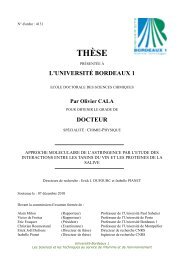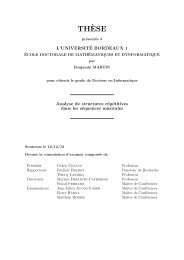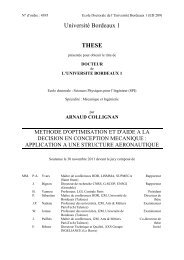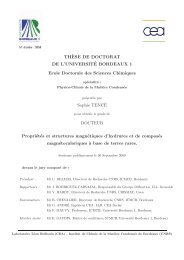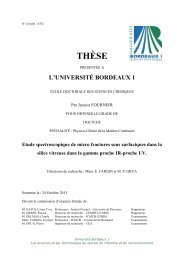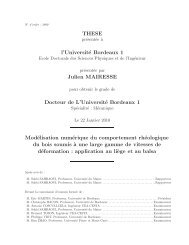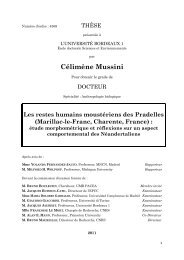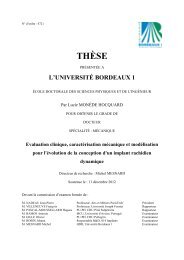de la structure à la croissance cellulaire - Université Bordeaux 1
de la structure à la croissance cellulaire - Université Bordeaux 1
de la structure à la croissance cellulaire - Université Bordeaux 1
Create successful ePaper yourself
Turn your PDF publications into a flip-book with our unique Google optimized e-Paper software.
118 M. Bourdon et al.<br />
The rate of organ growth could be also un<strong>de</strong>r the influence of genome size. From<br />
the data presented in Table 1, no obvious re<strong>la</strong>tionship between genome size and<br />
length of fruit growth could be observed. For instance, pear and apple (nonendoreduplicating<br />
species) have respectively a small (C-value ¼ 0.55 pg) and <strong>la</strong>rge (Cvalue<br />
¼ 4.50 pg) genome size and disp<strong>la</strong>y simi<strong>la</strong>r fruit growth lengths of around 21<br />
weeks. The same observation is also true for endoreduplicating species, such as<br />
tomato (C-value ¼ 1 pg) and pepper (C-value ¼ 4 pg), whose fruit both <strong>de</strong>velops in<br />
6–8 weeks. Thus, the positive corre<strong>la</strong>tion between genome size and life cycle<br />
shown by Bennett (1972) may not be applicable if confined to fruit <strong>de</strong>velopment,<br />
at least in this range of genome size.<br />
We also examined if the ability to exhibit endoreduplication was favored by a<br />
small genome size, owing to the fact that a higher nuclear DNA content as a result<br />
of autopolyploidy requires more time to replicate (Bennett 1972). From the 22<br />
different fruit species analyzed in Table 1, it seems that the occurrence and extent of<br />
endoreduplication is not re<strong>la</strong>ted to genome size, since endopolyploidizing fruits<br />
disp<strong>la</strong>y genome sizes ranging from 0.16 to 4 pg and nonendopolyploidizing ones<br />
from 0.43 to 4.50 pg.This result is in accordance with the findings of Barow and<br />
Meister (2003) who observed only a low negative corre<strong>la</strong>tion between genome size<br />
and endopolyploidization, which was contrary to a previous c<strong>la</strong>im based on fewer<br />
species (Nagl 1976).<br />
5 Molecu<strong>la</strong>r Control of Endoreduplication<br />
5.1 The Canonical Cell Cycle<br />
The canonical eukaryotic cell cycle is composed of four distinct phases: an undifferentiated<br />
DNA presynthetic phase with a 2C nuclear DNA content, termed the<br />
G1 phase; the S-phase, during which DNA is synthesized, with a nuclear DNA<br />
content intermediate between 2C and 4C; a second undifferentiated phase (DNA<br />
postsynthetic phase) with a 4C nuclear DNA content, termed the G2 phase; and the<br />
ultimate M-phase or mitosis. Mitotic cell division is the ultimate step in the cell<br />
cycle, and leads to the transmission of the genetic information from one mother<br />
cell to two daughter cells. The c<strong>la</strong>ssical cell cycle thus involves the accurate<br />
duplication of the chromosomal DNA stock in S-phase and its subsequent equal<br />
segregation in each nascent cell as a result of mitosis.<br />
The progression within the four phases of the p<strong>la</strong>nt cell cycle is regu<strong>la</strong>ted by a<br />
c<strong>la</strong>ss of conserved heterodimeric protein complexes consisting of a catalytic subunit<br />
referred to as cyclin-<strong>de</strong>pen<strong>de</strong>nt kinase (CDK) and a regu<strong>la</strong>tory cyclin (CYC)<br />
subunit whose association <strong>de</strong>termines the activity of the complex, its stability, its<br />
localization and substrate specificity (Inzé and De Veyl<strong>de</strong>r 2006). The canonical<br />
A-type CDK (CDKA; Joubès et al. 2000) harboring the PSTAIRE hallmark in the<br />
cyclin-binding domain disp<strong>la</strong>ys a pivotal role during the cell cycle as it participates



